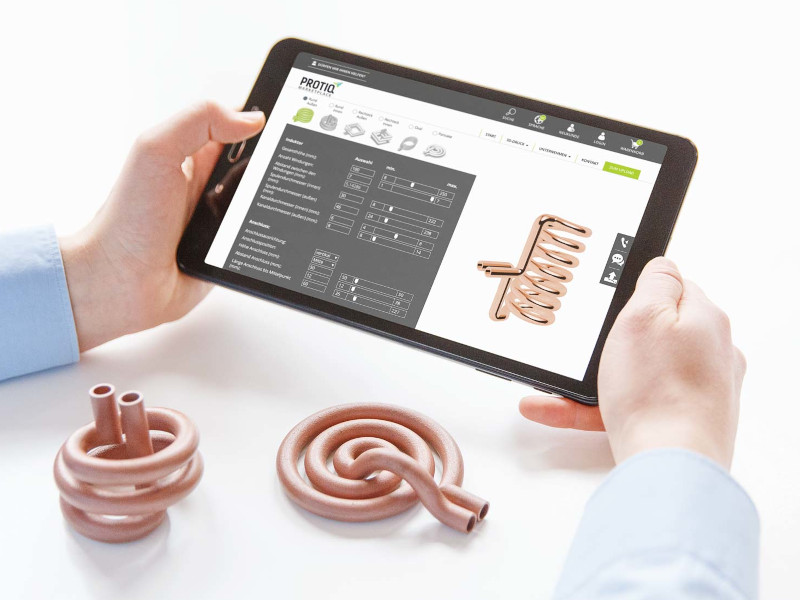3D printing software startup trinckle allows customers to create configurators for customizable 3D printed goods. This enables businesses to save time by automating their workflows. Its Paramate software make it possible to parametrically design customizable orthotics, grippers, production jigs, copper inductors, surf fins, optics, and jewelry.
Metal 3D Printing Pioneers Back 3D Printing Design Configuration
There’s a lot of potential in custom products when combined with 3D printing. What is holding the market back is software. Taking individual choices and spitting out 3D printable files is difficult. trickle automates this process and as such, along with Twikit, is one of few firms that is potentially enabling mass customization for additive manufacturing (AM). In a few seconds, anyone can use such a configurator to commission a 3D printed product. This is something that could really accelerate the growth of the AM industry.
“We are very pleased about the proof of trust in the face of the recession. Especially now, many companies are dependent on saving costs. In addition to significant savings potential, our range of solutions offers the opportunity to simplify production processes and roll them out globally. This enables completely new digital processes and business models in the sense of Industry 4.0, which are prepared for the future,” said trinckle managing director Florian Reichle.
Now, the company has raised €3 million to beef up its efforts in this area. trinckle hopes to use the money to grow its team and roll out its software worldwide. Interestingly, the round was led by HZG Group the investment fund run by the founders of Concept Laser (now owned by GE Additive), Kerstin and Frank Carsten Herzog.
 3D printed copper inductions coils made using trinckle’s software.
3D printed copper inductions coils made using trinckle’s software.This brings to the fore another 3D printing focused investor, alongside AM Ventures, 3D Ventures and Asimov. HZG invests in Series A rounds with a focus on 3D printing in the Deutschland (Germany), Austria, Confœderatio Helvetica (Switzerland) market. The firm is also building a world class R&D center, NADDCON in Lichtenfelds, formerly the center of basketmaking for Bavaria.
¨By significantly reducing the entry barriers to design creation and allowing recurring design tasks to be fully automated on demand, trinckle can give the whole additive manufacturing technology a decisive boost,” said HZG Group Managing Director Kerstin Herzog.
“The recent financing round is the next milestone in the development of our company. We are thrilled to have HZG Group on board, the VC investor who is both entrepreneurially experienced and technically highly versed in 3D printing. This is exactly the right combination at the right time to now take the company to the next level and scale it up,” said the technical managing director of trinckle, Marlene Vogel.
The Value of Designing 3D Printed Parts with trinckle
trinckle has disclosed that it has 30 manufacturing clients, including Volkswagen, Ford, Deutsche Bahn, and Airbus Helicopters. Traditionally people look at consumer-facing mass customization tools, especially in business-to-consumer markets. However, as trinckle shows, there are many more areas to explore out there.
For example, mass customization can be used as an internal tool for allowing workers on the factory floor to produce jigs and fixtures. Dental labs can service dentists via mass customized tools by fulfilling their 3D printed orders. End-of-arm tooling, induction coils, circuits, antennas, and nozzles are all items that are customized at scale—currently by hand.
For a company to industrialize 3D printing, is a significant undertaking. It takes millions of dollars and many months. There are a lot of parts out there where 3D printing can provide an edge, but where there is not enough part volume to justify the purchase a machine. For those cases, trinckle can enable a customer to set up a cost-effective service internally or externally to 3D print parts just as they need to be. Clients would not have to invest overhead or know anything about additive to use the components made in this way. The potential of these kinds of parts, available in their millions, is an untapped reserve of much potential for the 3D printing market.
All images courtesy of trinckle.
Subscribe to Our Email Newsletter
Stay up-to-date on all the latest news from the 3D printing industry and receive information and offers from third party vendors.
Print Services
Upload your 3D Models and get them printed quickly and efficiently.
You May Also Like
3D Printing News Briefs, July 2, 2025: Copper Alloys, Defense Manufacturing, & More
We’re starting off with metals in today’s 3D Printing News Briefs, as Farsoon has unveiled a large-scale AM solution for copper alloys, and Meltio used its wire-laser metal solution to...
3DPOD 260: John Hart on VulcanForms, MIT, Desktop Metal and More
John Hart is a Professor at MIT; he´s also the director of the Laboratory for Manufacturing and Productivity as well as the director of the Center for Advanced Production Technologies....
3D Printing News Briefs, June 28, 2025: Defense Accelerator, Surgical Models, & More
In this weekend’s 3D Printing News Briefs, 3YOURMIND was selected to join an EU Defense Accelerator, and PTC has announced model-based definition (MBD) capabilities within Onshape. Finally, a study out...
EOS in India: AM’s Rising Star
EOS is doubling down on India. With a growing base of aerospace startups, new government policies, and a massive engineering workforce, India is quickly becoming one of the most important...


































